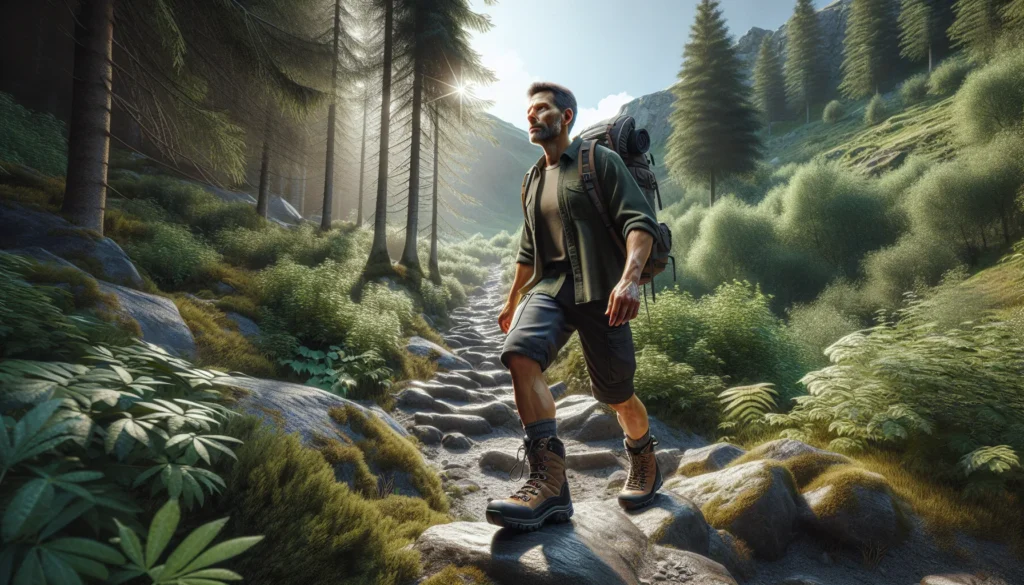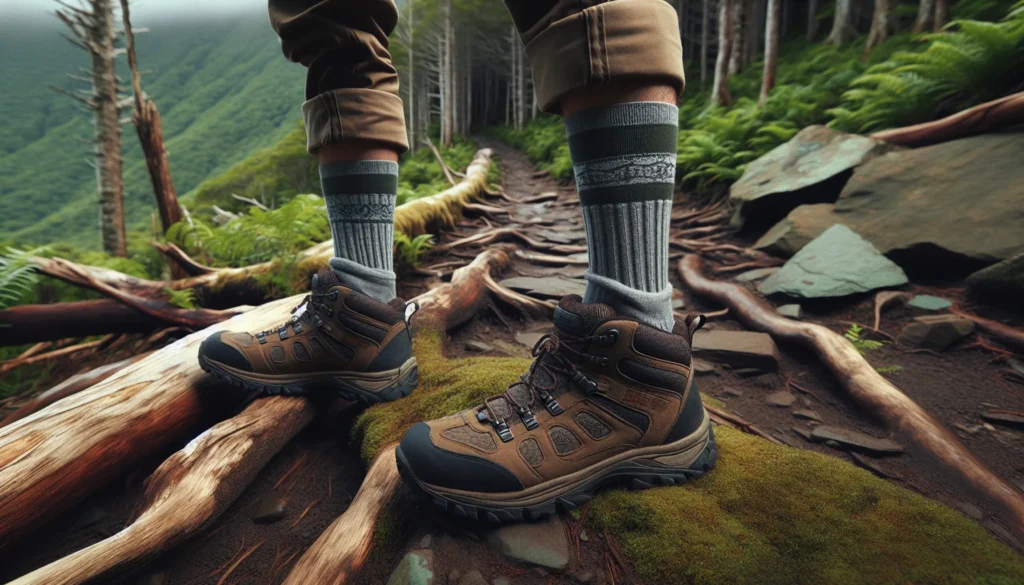Key Takeaways
- Proper foot protection is essential for hiking to prevent blisters, injuries, and infections while ensuring comfort and stamina on the trail.
- Choose appropriate footwear by considering terrain, fit, and features like waterproofing and breathability for maximum performance and support.
- Select the right hiking socks made of synthetic materials or merino wool to manage moisture, reduce friction, and prevent discomfort.
- Prevent blisters and hot spots with preemptive measures like applying moleskin, anti-chafing balms, or foot powders before hitting the trail.
- Maintain foot hygiene during hikes by keeping feet clean, dry, and rotating socks to minimize irritation and odor.
- Post-hike foot care includes soaking, moisturizing, and inspecting your feet for injuries to ensure recovery and prepare for future adventures.
Hiking’s one of my favorite ways to connect with nature, but let’s be honest—nothing ruins a trail faster than aching, blistered feet. Our feet do all the hard work out there, carrying us over rocks, through streams, and up steep inclines. It’s only fair we give them the care they deserve.
Why Foot Protection Is Essential While Hiking
Hiking puts constant pressure on feet, making protection vital for comfort and safety. Rocks, uneven surfaces, and prolonged walking stress muscles, joints, and skin, causing discomfort if precautions aren’t taken.
Unprotected feet are prone to injuries like cuts, blisters, and bruises from sharp objects or rough terrain. Wet or poorly ventilated footwear raises the risk of infections, such as athlete’s foot.
Proper protection improves stamina by reducing pain and fatigue. A well-cushioned sole absorbs impact, and snug fitting provides stability, preventing slips. Choosing the right socks minimizes friction, reducing blisters and hot spots.
Ignoring foot protection can turn a rewarding hike into an uncomfortable experience. By prioritizing footwear and maintenance, hikers enjoy smoother, pain-free adventures.
Choosing The Right Footwear

Protecting my feet on hikes starts with selecting the right footwear. Bad choices lead to discomfort, fatigue, and even injuries, so I ensure my shoes match the terrain and conditions.
Selecting Hiking Boots Or Shoes
I pick between boots and shoes based on the hike’s difficulty and length. For steep or rugged trails, I prefer high-cut boots for better ankle support and stability. On lighter or well-maintained paths, I go with low-cut hiking shoes for flexibility and reduced weight. I also check for durable outsoles with reliable traction to prevent slips on wet or uneven surfaces.
Considering Fit And Comfort
A proper fit reduces the risk of blisters and keeps me comfortable on long hikes. I always try on footwear with the socks I’ll be wearing while hiking. There’s enough room in the toe box to wiggle my toes but not so much that my feet slide. A snug fit around the heel and midfoot prevents rubbing without feeling tight. I pay particular attention to arch support and cushioned insoles to avoid sore feet after hours of walking.
Importance Of Waterproofing And Breathability
Wet feet ruin hikes, so I prioritize waterproof hiking boots or shoes for damp conditions or rainy seasons. Many come with Gore-Tex or similar membranes that block moisture while allowing sweat to escape. In hot or dry climates, I opt for breathable shoes made from mesh or moisture-wicking fabrics to keep my feet cool and dry. Adding gaiters helps protect against water, mud, or debris entering my footwear.
Proper Sock Selection

Choosing the right socks is crucial for keeping your feet comfortable and blister-free during hikes. The right socks provide moisture control, cushioning, and protection against friction.
Materials To Look For
I always recommend socks made from synthetic blends or natural fibers like merino wool. Merino wool manages moisture effectively, regulates temperature, and resists odors. Synthetic materials like polyester and nylon wick away sweat while staying durable. Avoid cotton socks—these absorb moisture and can cause blisters.
Layering For Extra Protection
Wearing liner socks under thicker hiking socks adds a layer of protection against friction. Liners made from synthetic materials or silk reduce moisture and prevent direct contact between your skin and the outer sock. Doubling up on socks can also improve cushioning for heavy packs or challenging terrains. Ensure both layers fit snugly without bunching to avoid discomfort.
Preventing Blisters And Hot Spots

Blisters and hot spots can quickly turn a hike into an uncomfortable experience. Keeping your feet protected requires proactive measures to reduce friction and moisture.
Using Preemptive Taping Or Moleskin
I use adhesive products like moleskin or medical tape to protect areas prone to friction before starting a hike. For example, I apply strips to common problem spots like heels, toes, and the balls of my feet. Moleskin is thicker and cushions skin well, making it great for areas already experiencing slight irritation, while thinner tape works better for preventive coverage. The surface beneath the tape should be dry and clean for better adhesion and effectiveness.
Applying Anti-Chafing Balms Or Powders
I rely on anti-chafing balms or foot powders to reduce friction and manage moisture build-up. Balms create a slick barrier on the skin, minimizing rubbing caused by shoes and socks. Powders absorb sweat and help keep the feet dry, which is essential in reducing heat and friction that lead to blisters. Common options like petroleum jelly, foot-specific balms, or talcum powder work well depending on personal preference and the hiking conditions. Applying these products before hitting the trail has consistently kept my feet comfortable.
Maintaining Foot Hygiene On The Trail
Foot hygiene plays a vital role in ensuring comfort and preventing issues while hiking. Taking small, consistent steps helps reduce the risk of blisters, odors, and infections.
Keeping Feet Dry And Clean
Dry, clean feet significantly lower the chances of irritation and odor. I wash my feet at the end of each hiking day using water and biodegradable soap, ensuring dirt and sweat are removed. If washing isn’t possible, I use moist towelettes to wipe them clean. Keeping my feet dry matters as much as cleanliness; I carry a lightweight towel to pat them dry and apply foot powder to absorb moisture. I also air out my feet during breaks to allow sweat to evaporate.
Rotating Socks During Long Hikes
Switching to fresh socks keeps feet comfortable and free from excess moisture. I pack at least two pairs of hiking socks, alternating between them during multi-day hikes. When I remove a worn pair, I hang them on my backpack to dry in the sun. This rotation minimizes dampness, reducing friction and creating a more comfortable hiking experience.
Post-Hike Foot Care Tips
Caring for your feet after a hike helps them recover and prevents long-term problems. After removing your gear, it’s essential to spend a few minutes focusing on post-hike foot care.
Soaking And Moisturizing Your Feet
I like to soak my feet in warm water to relieve soreness and reduce swelling. Adding Epsom salt can help soothe muscles and clean minor cuts. If a soak isn’t possible, rinsing with lukewarm water can still refresh them. After drying thoroughly, I use a hydrating foot cream or lotion to restore moisture lost during the hike. This keeps my skin soft and prevents cracking, which could lead to infections later.
Checking For Injuries Or Infections
I always inspect my feet for blisters, cuts, or redness after a hike. Treating blisters involves cleaning the area and applying a breathable bandage, while small cuts require antiseptic and proper covering. I also look for signs of infections like swelling, warmth, or unusual pain around wounds. If I notice anything concerning, I address it promptly to keep my feet healthy for future hikes.
Conclusion
Taking care of your feet while hiking isn’t just about comfort—it’s about ensuring every step feels as enjoyable as the journey itself. By prioritizing the right footwear, socks, and proactive care, you can prevent unnecessary pain and keep your feet happy on the trail. Trust me, your adventures will be so much more rewarding when your feet are ready to tackle whatever the trail throws at them. Treat your feet well, and they’ll carry you to incredible places!
Frequently Asked Questions
Why is foot protection important for hiking?
Foot protection is essential when hiking as it prevents injuries like blisters, cuts, and bruises caused by rough terrain. Proper footwear reduces pain, fatigue, and improves stamina, ensuring you enjoy your hike without discomfort.
What type of footwear is best for hiking?
The best footwear depends on the trail difficulty. High-cut boots are ideal for rugged terrains, while low-cut hiking shoes are better for easier trails. Look for snug-fitting, cushioned soles, and consider waterproof or breathable options based on the environment.
Why should I avoid cotton socks while hiking?
Cotton socks trap moisture, increasing the risk of blisters and discomfort. Opt for synthetic or merino wool socks, which manage moisture, regulate temperature, and resist odors, enhancing hiking comfort.
How can I prevent blisters during a hike?
Prevent blisters by minimizing friction and moisture. Use moleskin or medical tape on high-friction areas, apply anti-chafing balm or foot powder, and wear snug-fitting socks with proper footwear.
What is the benefit of wearing liner socks?
Liner socks add an extra layer of protection against friction, reducing the risk of blisters. They wick moisture away from the feet, keeping them dry and comfortable throughout the hike.
How can I keep my feet clean during a hike?
Keep feet clean by washing them with biodegradable soap at the end of the day or using moist towelettes if water isn’t available. Dry them thoroughly and rotate socks regularly to minimize moisture.
What should I include in post-hike foot care?
After a hike, soak feet in warm water with Epsom salt or rinse with lukewarm water. Apply a hydrating foot cream, inspect for injuries like blisters or cuts, and treat any issues promptly to ensure recovery.
Why is proper footwear fit so important?
Proper footwear fit prevents blisters, reduces discomfort, and ensures stability on the trail. Always try on hiking shoes with the socks you’ll wear and ensure a snug fit with no pressure points or slippage.
Should I choose waterproof or breathable hiking footwear?
Choose waterproof footwear for wet or rainy conditions to keep feet dry. Opt for breathable materials in hot climates to improve ventilation and prevent excessive moisture inside the shoes.
How can I manage hot spots during a hike?
Address hot spots early by applying moleskin, medical tape, or anti-chafing balm. These measures reduce friction and prevent blisters from forming, keeping your feet comfortable on the trail.

